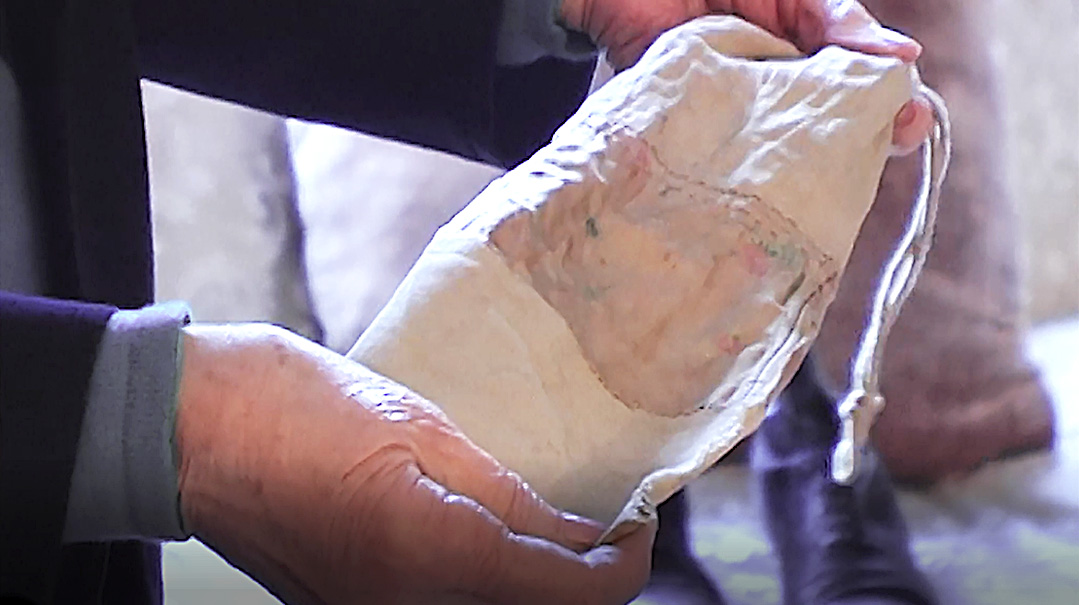Jenti’s Purse
| May 17, 2022A lifetime of memories, horror, and faith—all inside her drawstring purse

It was a simple cotton drawstring purse made of three scraps of material carefully sewn together with small, neat, even stitches. The rope-like band was made of a discarded piece of hemp.
My sister-in-law Jenti smiled as she showed it to me. “I have no idea how I found the fabric,” she told me. She'd been very fortunate to have acquired a needle, but there was no thread. So she had carefully pulled out some strings from her blanket, one of her few possessions. She shook her head.
“Can you imagine?” She pointed to the bag, which measured about 15 inches in length and five inches in width. “Everything I owned, all my possessions — and not only mine, but everything my sister Miriam owned as well — everything was in this bag. And even then, the bag wasn’t half full.”
I'd been Jenti’s sister-in-law for 60 years, yet I'd never seen this bag. We had a close relationship, but there were many things about Jenti I didn’t know. This visit was unusual. I'd come from New York with Michael Scwartz, a videographer who'd come to interview Jenti for Passage to Sweden, a documentary about the events that took place in Scandinavia during World War II.
Gently, carefully, Jenti removed the few items from the bag and placed them on her dining room table. There was a neatly folded German Deutschmark. “That was the only money I had when we left Germany,” she said. “Of course, I held onto it, perhaps I would need it at some point. It gave me assurance that I would continue to live.”
Then there was a small ordinary comb. Jenti held it up, and said with a rather sad smile, “I don’t even know why it was so important for me at that time to own a comb. I always had a very full head of hair, thick and curly, so I always needed to brush it. But when I came to Auschwitz my hair was cut off, so there was no need for a comb. But you know,” she concluded, “I just had such strong bitachon, I just knew there would come a time when life would be different. I always believed I would somehow survive.”
I noticed something that looked like a dog tag. “What is that?” I asked, surprised. Jenti rolled up her sleeves. “Look,” she said, “they didn’t give us numbers. We were brought to Auschwitz Shavuos time in 1944. Everything happened very rapidly. Would you believe that we celebrated Pesach that year in our own home, like always? It’s almost impossible to understand that in Marmarosh [the region where Sieghet and Satmar were located, which was then in Hungary] we were unaware of the gas chambers, of the destruction of thousands of Jews from Poland, Latvia, Lithuania and so many other countries. We just didn’t know that this was happening all around us. Soon after that Pesach we were placed in a crowded ghetto with ten thousand people, and after Shavuos the deportations began. Daily transports were brought to concentration camps.
“We were so unbelievably unaware, so innocent, when we left our beautiful home, that we dressed in beautiful Shabbos clothes for the trip. [We] even brought damask linen and bedding, and of course bags filled with food for the journey. When we arrived in Auschwitz my father read the sign Arbeit Macht Frei and said he wasn’t afraid of work. He had owned a big business in Hungary and even had business partners here [in Auschwitz] from whom he purchased wood shavings for his oil manufacturing.
“We exited the train, and on the platform, I remember Joseph Mengele with his white glove directing us to separate left and right. That was the last time I saw my parents and closest family members.
“Would you believe,” she added, “that I saw my sister Miriam on the left line, and I just walked over to pull her across to my line? I just wanted someone from the family to be with me.” I was speechless. My sister-in-law was always a very law-abiding citizen, always paying taxes and bills, never getting traffic tickets.
“Wow, Jenti,” I exclaimed. “I can’t believe it.” We both laughed, and then Jenti resumed her story.
The new arrivals were rapidly sent to the gas chambers, she explained, so the Nazis decided it would be pointless to waste time etching numbers into their arms. After three months in Auschwitz, Jenti was among the 650 women sent to Fallersleben, a Volkswagen labor camp, to produce military munitions. There, they were given these dog tags with numbers. Thanks to the Germans’ systematic archives, everything was carefully recorded. In 1998 Jenti was compensated for the forced labor, which of course could never compensate for the inhumane life in a forced labor camp.
These labor camps were satellites of concentration camps, and Jenti lived in constant fear of the selections, where each day, young women were “selected” and sent to the gas chambers in the adjacent concentration camp.
There was the daily Appell, where all 32,000 inmates stood five abreast for roll call, sometimes for hours, often in cold and rainy weather. For the starved and weak prisoners, this was torturous. People fainted — which literally meant death. Yet being selected to work in a labor camp was preferential, as the Germans needed the slave labor to help them in their ambition to rule over Europe, so the laborers received “better” treatment.
The living conditions in the labor camp were horrendous; 14 girls shared one bed, alternating head to foot. Jenti slept near a window, and when it rained, she had to sit up to avoid getting completely soaked. The so-called soup the prisoners were served was made of grass and even had sand in it. There was one bowl given to five girls to share. No spoons. The meager portions of black bread contained sawdust. Sometimes there was a tiny square of margarine and once, just once, a spoon of jam for everyone. And sometimes the inmates were given nothing — no food, no water — for two or three days.
Their clothing consisted of one dress and a pair of shoes, whatever they could find — they were not given underwear or socks. That single dress was pulled from a pile without any regard for size, so a big girl could get a tiny dress barely covering her body, and a short, slender girl could be given a huge dress. This dehumanizing and embarrassing process was how the Nazis chose to introduce them to the camp.
Jenti was lucky to somehow have found a blanket, which she treasured and brought with her to Sweden and then Boston, until one day it caught fire and had to be discarded.
Jenti carefully removed a clove of garlic from the bag. She recalled how she had stood near the fence of the camp and a passerby had tossed it to her. A piece of the peel fluttered like a feather and settled on the table. The inside was completely dry and brittle. “I kept it,” said Jenti, “because garlic brings luck. It’s supposed to protect us from evil. There are stories of people’s lives being saved from dangerous times or infectious diseases. Anyway,” she said, “I’m here. I remained alive. So for sure it brought me good luck.”
At the end of the table was a pair of shoes, fine lace-up leather shoes that would reach the mid-calf when worn — very stylish in the ’40s in Hungary. They still looked perfectly wearable. “These shoes were mine, from home,” Jenti told us. “I wore them on that miserable train ride to Auschwitz, I wore them in the concentration camp and the labor camp, and I came to Sweden with these shoes. They literally saved my life in the death march.”
When the inmates were required to undress for showers to be disinfected, they had to remove all their clothes. Their shoes were placed in a pile, and after the showers they had to select prison uniforms from one pile, and shoes from the pile where they’d placed them before the shower. Those whose shoes did not fit properly were unfortunate: shoes that were too small were very painful, and shoes that were too big were also a serious problem. In the winter, the ground in the camp was very muddy — “like yellow clay,” Jenti recalled. Her sister Miriam’s shoes had no soles. They were eaten up by the mud.
Miraculously, after her shower, Jenti had found her very own shoes.
Now, she showed them to us, then turned them over to display the solid soles and heels. Even the taps were still there. “I came to Sweden with those shoes and I never wanted to discard them. A German shoemaker repaired them for me. These shoes literally saved my life,” she repeated.
In April 1945, the inmates were forced into a death march in an attempt to remove evidence of the situation in the camps. Many people lost their lives in those final days of the war on these unbearably difficult marches. But, in part thanks to her shoes, Jenti survived, and lived to see the Germans surrender on May 4,1945.
“We were free,” said Jenti, with a sad smile, shaking her head. “What did that mean, though? There was no home to return to, and we had no resources of any kind.”
The Allied soldiers were kind, and offered the liberated prisoners some cigarettes. Jenti didn’t smoke, but she used the cigarettes as barter. First, she “bought” herself a toothbrush. I wasn’t surprised. Jenti was always careful with her appearance, cleanliness, and her personal hygiene.
After the death march, Jenti had arrived in Salzwedel, a satellite camp in the Soviet zone. “The Allies told us that under no circumstances should we remain in Salzwedel,” she remembered. “It was under Soviet rule and our lives would be in great danger. Germany had been divided into four zones: British, American, French and Russian. They suggested we relocate to Bergen-Belsen in the British zone, where there were many Jewish survivors. We collected all our cigarettes, a group of 25 girls, and hired a truck to bring us there.
“I was always together with my own small group — my sister Miriam, my cousins Henshi and her sister, and the rebbetzin of Vizhnitz, Rebbetzin Hager, who was also from Marmarosh. We were what was called lagerschwester, we became like sisters, caring for and supporting each other. This became our new family.
“I thought Auschwitz had been a nightmare, but Bergen-Belsen was even worse… There were naked, dead bodies everywhere. People who looked like skeletons, without any expression of emotion, robot-like. It was a sight I can never forget. My life had been awful, but paled in comparison to this scene.
“And then the White Buses came, like angels from heaven. Folke Bernadotte, vice-president of the Swedish Red Cross, had negotiated with Himmler and Schellenberg for prisoner exchanges of political prisoners from the Scandinavian countries. This project then extended to other survivors, eventually including Jewish women from Ravensbruck. From the middle of March until May 1945, 15,000 inmates were released within a 54-day period. And then in June, another 10,000 were released to Scandinavia.
“The last groups consisted of individuals who were ill and needed medical care. Rebbetzin Hager wasn’t feeling well, my sister said her stomach hurt, and my cousin also went to the hospital. They were asked if they wanted to go to Sweden to recuperate. They agreed, but refused to go without their siblings. And that is how we all came to Sweden.
“We were brought to Lubeck, Germany, and some left by ship. We went by land to Padberg, Denmark and then to Copenhagen. We arrived in Malmo, Sweden, on a ferry. I knew nothing about that country. I had probably learned something about it in school, but really it was a completely unknown place. Let me tell you, I thought we were in paradise. We were greeted with hot cocoa and cakes. We were given brand new clothes, shoes, undergarments — anything and everything we could have wanted. And people gave us chocolate, flowers and gifts. The care and compassion was fantastic.”
Eventually, after four weeks of quarantine, the group came to a DP camp near Lovo, Stockholm. My brother Mendel volunteered to assist with social activities for refugees in nearby camps like Farnabu. Men and women were placed in separate camps and my brother arranged events where they could meet. This resulted in many marriages and subsequent births of many babies. The survivors wanted life, to recreate and build new families.
That’s how my brother Mendel met his wife, Sara Einhorn, whom he married in Sweden. Jenti, who was skilled in embroidery, came to our home to prepare a trousseau for Sara, whose family had lived in a village near her family’s back in Hungary. There she met my brother Sholom, and they likewise married in Sweden.
The rest of Jenti’s group of lagerschwester also began to find their own paths. Rebbetzin Hager saw her husband’s name on a list of survivors — he’d gone to Bergen-Belsen hoping to find her. Eventually they met in Sweden, and the joy of their reunion was like a real miracle.
Henshe’s young sister was sent to a special Jewish school for young female survivors in Lidingo, a suburb of Stockholm. Tragically, she soon became very ill and died from tuberculosis. She was buried in the cemetery outside Stockholm in a section where numerous young women survivors, who had also arrived in Sweden in poor physical health, were buried. At least they were properly buried in a Jewish cemetery, in a grave with a marker.
Before the war, Jenti’s sister Miriam had been engaged to a young man from her hometown. Now, against the advice of all her friends, she returned home to Hungary to look for him. She did find him, but unfortunately, he’d assumed Miriam was no longer alive and was married to another woman.
Now Miriam was stuck in Hungary, which was under Communist rule, unable to return to Sweden. The two sisters, the only ones from their large family who had survived the war, remained separated for more than ten years.
Jenti and her husband, Sholom, arrived in Boston in 1948, and they joined our family: my parents, Mendel and Sara, my sister Leya, and me. We lived in Roxbury, where we’d settled upon our arrival from Sweden in 1947.
Later, they moved to Brookline, where they had two sons — Shia, who was named for Jenti’s father, and Izzy, named for my father, Rabbi Yaacov Yisroel Zuber — as well as a daughter, Rivkah, named for Jenti’s mother. The couple established a thriving business, Zuber Embroidery. My brother was the manager and Jenti, who had what my mother called “goldene hent” (golden hands), handled the embroidery. They started with monograms and moved on to insignias on uniforms of all kinds.
Jenti was busy after retirement as well. She crocheted baby blankets for countless young mothers, both relatives as well as anyone in need. She spent countless hours crocheting shawls for women in nursing homes or the homebound elderly. For family members, especially newlyweds, she made beautiful afghans with glorious colors and intricate designs. And her home was filled with antimacassars, embroidered tablecloths, pillows with geometric designs, and even beautiful dolls to hide rolls of extra toilet paper.
Jenti spent summers in a hotel in Bethlehem, New Hampshire, where many survivors gathered and shared memories. She watched Holocaust films and documentaries and read books of that genre. She must have read Night by Elie Wiesel at least three times, and she was very excited when Anne Frank’s diary was published, as she’d really identified with her in several ways. When she watched Schindler’s List and listened to him describing the conditions in the camp, she said, “Sometimes when I listen to deniers of the Holocaust, I myself wonder if maybe they really are right. I think back on what happened, and it is so inhuman, so ugly and frightening, I wonder how I really lived through all that.” She looked bewildered.
Jenti had always had emunah and an unbroken belief in her survival, she told the videographer. But “I can’t blame those who left Yiddishkeit,” she said. “Actually, it is more unbelievable that so many of us stayed frum.”
“I don’t hate,” she said. “I don’t want to be filled with hate. But I will never, under any circumstances, buy German products. I absolutely do not want them in my house.” She shook her head sadly. “And time does not heal, it only gets worse.”
Jenti never wanted to return for a visit to her hometown. She felt it would be very tragic and upsetting. Nor did she want to visit any concentration camps. When I told her about my visit to Ravensbruck and Mauthausen, she became quite annoyed. “How can they beautify these places, make them like museums of some kind?” she asked in anger. “These places were the most inhumane, brutal places. Changing their appearance is offensive to us survivors who still have nightmares from these days.”
One day, Jenti sat down with her sister Miriam and they made a list of their family members who had perished in the Holocaust. There were 154 names.
“Chana,” she told me, “that’s why I always found it difficult to celebrate Shabbos and Yom Tov with your family. It reminded me so sharply of my home and all that I had lost.”
At the interview’s end, Jenti carefully, somberly replaced her few mementos in the cotton drawstring purse. The reichsmark, the comb, the clove of garlic.
She held the name tag in her hand a few moments before placing it in the bag, gently fingering the engraved numbers.
“I had no passport. No identification papers. And of course, not even a birth certificate. But I never became a number. I always knew that I was Jenti Gancz, the daughter of Shia and Rivkah Gancz. No matter what happened, no matter where I was, I knew who I was.”
Jenti passed away in 2010, but her life was a blessing for us all. Her numerous descendants, grandchildren, great-grandchildren and even great-great-grandchildren are building beautiful homes in Boston, New York City, Crown Heights, New Jersey, Baltimore, and Miami, and in Beitar, Tzfat, and Yerushalayim. They’re dedicated to a life of Torah and mitzvos, proudly following in the footsteps of their ancestors.
(Originally featured in Family First, Issue 793)
Oops! We could not locate your form.







